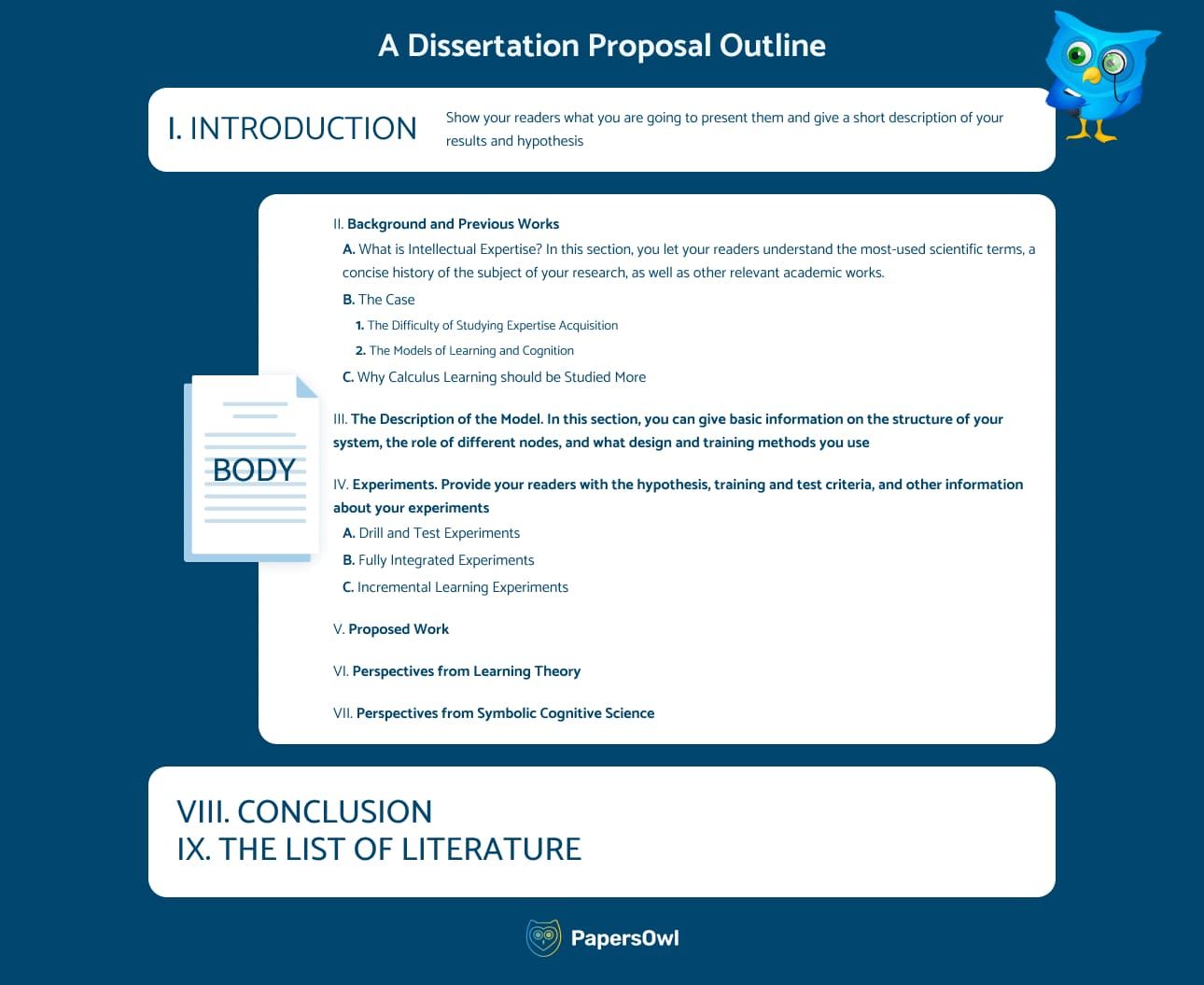Writing a Dissertation Proposal: Outline and Example
Table of contents
- 1 What is a Dissertation Proposal?
- 2 How to Write a Proposal for Dissertation or Thesis?
- 3 Advice for Writing a Dissertation Proposal
- 4 Dissertation Proposal Example
- 5 Mastering the Art of Thesis and Dissertation Proposals
Are you gearing up to embark on the exciting journey of crafting a research proposal for your upcoming dissertation or thesis? If so, you’re in the right place! Creating a research proposal is like taking the very first step in building the foundation of your entire academic project. It is your opportunity to pitch your research idea, outline your plan, and convince your academic committee that your dissertation or thesis is worth pursuing.
However, to many students, writing a Ph.D. proposal seems daunting. Do you fall into a similar category? Worry no more. We are here to guide you through how to write a proposal for a dissertation or thesis, making it as clear and straightforward as possible.
In this article, we will break down the essential steps to help you create a compelling research proposal that stands out. Whether you’re a graduate student embarking on your first thesis or a doctoral candidate looking to refine your research pitch, professional thesis writer service can provide valuable support alongside these guidelines. We’ve got you covered.
Here is a glimpse of what we will explore in this article:
- After reading this article, you will understand how to write methodology in a research proposal.
- You will gain a clear understanding of what a research proposal is all about.
- The article provides an in-depth discussion of the key components of the dissertation proposal structure.
- Allocating time, staying organized, setting a realistic scope, and citing sources accurately are crucial for creating a compelling dissertation or thesis proposal.
- The article provides insights into an example of a dissertation proposal.
What is a Dissertation Proposal?
Think of a research proposal for a dissertation as a roadmap for your academic adventure. It is the plan that points you in the right direction for your dissertation or thesis. To write a stellar Master’s research proposal finding the right topic to compose the dissertation proposal outline is crucial. Without the right thesis or dissertation topic, your paper will lack the depth, enthusiasm, and quality needed for success.
When you write your dissertation or thesis proposal, it has certain parts like an introduction, goals, a review of what has already been written, how you will do your research, what it all means, any limits, and a list of your sources. However, it is worth remembering that none of it is set in stone and can change depending on your study, school, or degree.
Strong research proposals demonstrate good research abilities and require the instructor’s feedback. Students who put in the effort and time to make their proposals clear and to the point are on the right track to academic success.
The research proposals should be complete, persuasive, and properly structured. While the research proposal serves as a valuable guide, it is still advisable to seek any further guidance required from your instructor or others in your department. Doing so will ensure that your projects adhere to all the academic rules.
A research proposal is a big deal when aiming for a higher degree. Writing a proposal for a dissertation that is simple but thorough can be challenging. Still, when you stick to the plan and get valuable advice from experts, you can build a strong foundation for your research project. Therefore, your success is assured.
How to Write a Proposal for Dissertation or Thesis?
When it comes to crafting proposals, the way you structure them up is super important. You are not alone if you are curious about writing a dissertation proposal and what it involves. But here is the deal: no universal format fits everyone.
Picking the very first dissertation proposal writing template and structure you come across might not be the best idea. Instead, you should choose a format that fits your paper like a glove. You must ensure you cover all the necessary parts, like your report’s main points, goals, and how you plan to do your research. Also, before you write a dissertation research proposal, get all the details about its structure.
Here are the key components of a thesis or dissertation proposal:
Introduction
Introducing a dissertation or thesis proposal is critical in setting the stage for your research journey. Think of it as the opening act of a play; it needs to grab your audience’s attention and give them a clear sense of what to expect. This article will shed light on the vital components of a compelling introduction.
Rationale:
Explaining why your proposed research is necessary is crucial to kicking things off. What gap in existing research knowledge does your study aim to fill? You must highlight the significance of the research problem you are addressing to show that your work is not just an academic exercise but contributes to the broader field.
Purpose:
Next, the introduction of your thesis or dissertation proposal must include a clear purpose for your research. It should clearly answer the question, “What are you trying to achieve?” Clearly state the main objective of your research paper, which gives context to your study.
Research Question:
The heart of your introduction is the research question. It is the central query that your dissertation or thesis seeks to answer. Make it concise, specific, and engaging, as it will guide your entire research.
Hypothesis:
If applicable, introduce your hypothesis. It is an educated guess about the expected outcome of your research based on existing knowledge. It helps set clear expectations for your study.
Aims and Objectives:
Conclude the introduction by outlining the aims and objectives of your research. Aims are broad, overarching goals, while objectives are specific, measurable steps that help you achieve those aims. Outlining the aims and objectives provides a roadmap for your research.
By addressing these elements in your introduction, you will give your readers a clear understanding of your research paper and demonstrate that you have thought critically about the importance and direction of your dissertation or thesis and the background of your research. It is like saying, “Welcome to my research journey; here’s why it matters, what I am trying to achieve, and how I plan to get there.” It will lay a solid foundation for the rest of your proposal.
Define Your Methodology
The research methodology section in your PhD dissertation proposal is a critical part. It is where you lay out how to gather and analyze your data. This part explains your approach, like the research methods and theories you will use, whether you are into numbers (quantitative), words (qualitative), or a mix of both. Also, it is about how you will get the data, what you will do with it, and the tools you will use.
No matter how clearly we describe them, this might confuse many students. It is where PapersOwl steps in to save the day. If you find defining your methodology in your thesis or dissertation proposal tricky, professional writers are ready to assist you.
Moreover, it is crucial to give valid reasons for your methodology selections. It will ensure the validity and reliability of the study’s findings.
Literature Review
In your doctoral dissertation proposal, the literature review section should showcase the books and materials you have used for your research. Think of it as giving credit to the sources that helped you understand your topic better or served as references for previous academic studies.
If tackling a literature review for your thesis or dissertation feels overwhelming, there is an alternative: consider taking help from a dissertation writing service. The literature review is your chance to demonstrate how your work fits into the bigger picture. It is about listing your sources and showing why they matter. Here are some pointers to keep in mind while doing a literature review for your thesis or dissertation:
- Do not shy away from discussing the stuff you disagree with. Everyone has got their take on things, and that’s what makes it interesting.
- Make sure to use proper citations to back up your ideas. It will make your proposal look more credible and worth reading.
- Compare and contrast different theories, arguments, and debates, and then throw in your two cents on how to find common ground.
- Connect your research to the existing literature and explain how it will progress the subject area.
Anticipate Challenges and Limitations
When crafting a proposal for your dissertation, you must not forget to talk about the research limitations – it is a big deal. You must understand that many research topics can be pretty complicated, and by pointing out these limits, you’re saying, “Hey, I know the ins and outs of what I am dealing with.”
Give some real-life examples of these limitations that might come into play, like time constraints, tricky data collection, needing a bigger group to study, or people dropping out of your study. It is like telling your readers, “Here is the road I’m walking, and here are some potholes I might stumble upon.” By doing so, you are being upfront about the challenges you could face on your research journey.
Consider Ethical Considerations
When it comes to research proposals, ethics are a big deal. As a researcher, you must ensure your study is above board and follows ethical considerations. It means considering how you collect data, keeping your participants’ info private, and getting their consent to be part of your study. It is like doing your research the right way.
By addressing these considerations, you show your commitment and willingness to conduct ethical research. Staying honest and responsible throughout the process is a sure way to steer yourself toward creating an outstanding thesis or dissertation.
Present Research Timeline
In the prospectus, it is standard and smart to give your supervisor an idea of when you will hand in your work. You can break it down into steps, like when you finish each chapter. But here is the key – be realistic. Make sure you have enough time for research before diving into writing. This way, you will have a strong base of knowledge, and you will not need to speed through the writing the dissertation proposal part.
Outline of Future Work
When it comes to outlining your future work in your thesis or dissertation proposal, it is all about showing your dedication and commitment to the topic. It is where you paint a picture of what you plan to dive into after completing your thesis or dissertation. It is like saying, “I am not done yet, and here is what’s next.”
By outlining your future work, you demonstrate that you are in it for the long haul and are not just stopping at your current study. You show that you are passionate about your field and eager to contribute. It means saying, “It is just the beginning, and I have big plans.”
Conclusion
While a conclusion is not mandatory, it is kind of like the cherry on top. It is a great way to wrap things up by reviewing your main points and revisiting why you picked this topic, how you researched it, and what you expect to find.
When you offer your readers a quick recap, it’s like saying, “Hey, remember what this was all about?” It’s a neat way to connect the dots and ensure your research sticks in their minds. A solid conclusion is like leaving a strong impression, much like the final bow in a great performance.
Advice for Writing a Dissertation Proposal
If you are one of those students wondering how to write a dissertation proposal, do not worry; we have some handy advice to make the process smoother. Following this advice is super important for a bunch of reasons. And remember, there is always the option to check out the best essay writing service if you need some extra help.
When you have a well-written proposal, it is like having a golden ticket. It can help you get the green light from your advisor and committee. Plus, it helps you get your research goals, methods, and what you hope to find all sorted out. It not only saves you time but also makes your work top-notch.
By following this advice, you are showing you know your stuff and proving you are a pro-researcher. That can really open doors for you in your academic and career journey. So, let’s dive into these practical tips to make the whole process a bit quicker and smoother:
- First things first, give yourself enough time for research. Rushing things can lead to all sorts of problems, especially time crunches.
- Remember that the folks reviewing your proposal have stacks to go through. So, make sure your work is organized and crystal clear. It will help you get to the writing part faster.
- A dissertation or thesis proposal is a work in progress, not a final product. Changes are expected, so don’t stress about it.
- Be clear about your research questions and ideas, and make sure they are doable. Your proposals are judged on whether you can pull them off and how ambitious they are. Your ideas should also fit right into your field.
- Show your passion for your research topic. Let your excitement shine through by sharing a personal story or explaining why this topic is important for your future studies and academic goals.
- When it comes to your sources, give credit where it is due. Use your own words or quotes properly to avoid plagiarism. Remember to make a list of all the sources you used. Keep your writing clear, to the point, and well-organized.
- Before you hit that submit button, give your work an excellent read to catch any errors.
Dissertation Proposal Example
Having access to great examples is a big help when working on a dissertation. You will come across many dissertation proposal samples, but not all examples are equal.
Imagine you are working on a prospectus for something as fancy as the computational model of acquiring intellectual expertise. Sounds complicated, right? Here’s the scoop: keep your paper’s title straightforward so people know what it’s all about. And do not forget to mention your university to give it that official touch.
Now, the abstract might be short, but it is a big deal. It is like the sneak peek that helps readers understand what your project is all about. Once your abstract is good to go, it is time to organize your info into different sections. You will usually have an introduction, methodology, conclusion, and more. Give each part some attention to make sure your writing flows smoothly and makes sense.
Here’s a quick example of what the structure of a dissertation proposal might look like:

Remember that this example works well for cognitive science studies, but things might be a bit different for other subjects.
Mastering the Art of Thesis and Dissertation Proposals
Embarking on crafting a proposal for your thesis or dissertation can feel daunting. However, remembering that it is a path well-trodden by countless scholars before you is worth remembering. In this guide, we will take you by the hand and walk you through the essential steps.
From understanding what a research proposal is to nailing down the key components and the pitfalls to avoid. By the end of this journey, you will be armed with the knowledge and confidence to tackle your proposal with finesse. So, let’s roll up our sleeves and dive into the thesis and dissertation proposals world. It’s a journey worth taking, and the destination? Your academic success.






